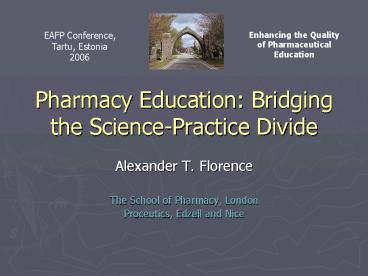Pharmacy Education: Bridging the SciencePractice Divide - PowerPoint PPT Presentation
1 / 27
Title:
Pharmacy Education: Bridging the SciencePractice Divide
Description:
The seamless transition between science and practice ... Labile medicaments (gene products, proteins, antibodies) Cytotoxic products ... – PowerPoint PPT presentation
Number of Views:22
Avg rating:3.0/5.0
Title: Pharmacy Education: Bridging the SciencePractice Divide
1
Pharmacy Education Bridging the Science-Practice
Divide
EAFP Conference, Tartu, Estonia 2006
Enhancing the Quality of Pharmaceutical Education
- Alexander T. Florence
- The School of Pharmacy, London
- Proceutics, Edzell and Nice
2
Future
Science Practice
3
Main thesis quality is to do with being fit for
purpose
- Principally ensuring
- The seamless transition between science and
practice - Basing practice on science and science for
practice - Ensuring appropriate science
- Allowing different emphases
Is pharmacy fit for purpose?
4
Challenging false dichotomies
The false dichotomy between the clinic (practice)
and laboratory (science) important not to fall
into the trap of believing that modern practice
is about something else than knowledge.
5
A timely topic
Medicine, if anything, is becoming more complex
as we unravel more about the science of the body
and the way drugs interact with it and are
delivered to their targets and used by patients
surely the heart of the pharmaceutical
sciences and practice
6
Course Content Judgements
- Intrinsic value of knowledge
- Utility
- Philosophical value
- Responsibility
- Enrichment
- Questions posed on High School Science by the
American Association for the Advancement of
Science (AAAS) Science for All Project
7
(1) Intrinsic value of knowledge
- Is the material we are presenting so important in
pharmacy now? - Will it be important in the future so that it
must be taught? - If we argue that it is important, how have we
come to that conclusion?
8
(2) Utility
- Is the proposed material knowledge or skills -
- vital for application in the work environment in
any of the branches of pharmacy? - Is it part of the unique pharmaceutical knowledge
base? - How have we arrived at the decision as to
utility?
9
(3) Philosophical value
- Does the proposed content encourage students to
think of the wider issues affecting their future
profession, their unique role and place in health
care systems? - How does it advance their role in reducing risk
to patients and enhancing care? - Does it give them pride in the achievements of
pharmacy and an understanding of the historical
context of pharmacy?
10
(4) Responsibility
- Does the content allow our students to
participate intelligently in discourse about
their role and responsibilities?
11
Purpose of Courses
- Preparation for practice now or the future? What
practice?
12
Designing and providing courses for the future
avoiding errors of judgement
- Prediction of the future cannot be based on fact
it is based on intelligent (i.e. informed)
guesswork founded on research which makes the
future - Mistakes can be costly
13
Extemporaneous preparation
Extemporaneous preparations
- Labile medicaments (gene products, proteins,
antibodies) - Cytotoxic products
- Paediatric medication
- Domiciliary care products
- Individualised dosage forms
14
Not only new therapies but the pharmacy of new
therapies
15
New approaches eg in utero
Personalised medicines
16
Defining the discipline
PHARMACEUTICAL SCIENCES PRACTICE (Not
everything about drugs the body and life)
17
The need for new approaches
Because of the
- Variability of human responses to medicines
- Unpredictability of adverse drug reactions
- Slow progress with gene therapy and the therapy
of many disease states eg cancer - Potential of the application of knowledge
- of the human genome to individualise therapy
and minimise risk - Complexity of new therapeutic entities
18
Does the science in our courses underpin the aims
of practice?
- Maximising patient health
- Minimising illness
- Optimising treatment with medicines and devices
- Monitoring outcomes
Pharmaceutical Science
Application of Science
Practice
19
Connections
- Must ensure that the science we teach has the
appropriate connections, that its ramifications
in practice are explained - More overt efforts made in teaching to identify
the problems in practice and to connect these to
the relevant science
20
Spreading
Bacterial adhesion
Adsorption
Wetting
Dissolution
Crystallisation
Polymer surfaces
Crystal surfaces
Micro- nano- particles
Precipitation
Solid surfaces
Cell uptake
Crystalluria Toxicity
SURFACE CHEMISTRY
Liquid Surfaces
Adsorption
Surface tension
Interfacial tension
Surfactants
Antibacterials antivirals
Emulsification
Formulations
21
Mapping problems in practice now and the
predicted future to science..
22
Mapping knowledge to problems in practice
Practice
Drug Delivery Science
Problem
In vivo destination
Adhesivity
Adverse Reaction to Medication
Nature of formulation
Tonicity, etc
Pathology
Physical action
Instability/ malfunction
Drug
Excipient
Dose form
Drug Specific
Class effect
Other
Preservative
Colour
Surfactant
Pharmacology
Formulation Science
Chemical
Physical
Complexation
log P
Precipitation
Hapten formation
Physical Pharmacy
Cross-reactivity
Medicinal Chemistry
23
Mapping knowledge to problems in practice
Drug Delivery Science
Paradoxical bronchoconstriction
In vivo destination
Adhesivity
Adverse Reaction to Medication
Nature of formulation
Tonicity, etc
Pathology
Physical action
Instability/ malfunction
Drug
Excipient
Dose form
Drug Specific
Class effect
Other
Preservative
Colour
Surfactant
Pharmacology
Formulation Science
Chemical
Physical
Complexation
log P
Precipitation
Hapten formation
Physical Pharmacy
Cross-reactivity
Medicinal Chemistry
24
Adverse reactions to paclitaxel
Drug Delivery Science
Taxol Reaction
In vivo destination
Adhesivity
Adverse Reaction to Medication
Nature of formulation
Tonicity, etc
Pathology
Physical action
Instability/ malfunction
Drug
Excipient
Dose form
Drug Specific
Class effect
Other
Preservative
Colour
Surfactant
Pharmacology
Formulation Science
Chemical
Physical
Complexation
log P
Precipitation
Hapten formation
Physical Pharmacy
Cross-reactivity
Medicinal Chemistry
25
The synthesis of knowledge
A tree of knowledge
26
Where from here?
- Ensure continuity of themes and subjects
throughout the course and ensure that gained
knowledge does not atrophy - We need the confidence to instil in students that
courses have been designed for good reason and
that they are the best that we can design
deliver
27
We need research to point to the future
nanotechnologies..stem cell therapy gene
therapy remote electronic delivery of drugs
individualised medicine
We need to think not only of the horizon but
beyond































